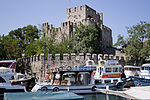Phiela
Ancient Bithynia geography stubsFormer populated places in TurkeyHistory of Istanbul ProvinceIstanbul Province geography stubsPopulated places in Bithynia
Phiela or Phiale was a coastal town of ancient Bithynia located on the Bosphorus. Its site is located near Körfez in Asiatic Turkey.
Excerpt from the Wikipedia article Phiela (License: CC BY-SA 3.0, Authors).Phiela
2. Çevre Yolu,
Geographical coordinates (GPS) Address Nearby Places Show on map
Geographical coordinates (GPS)
| Latitude | Longitude |
|---|---|
| N 41.091332 ° | E 29.067372 ° |
Address
Fatih Sultan Mehmet Köprüsü
2. Çevre Yolu
34810 , Kavacık Mahallesi
Turkey
Open on Google Maps







